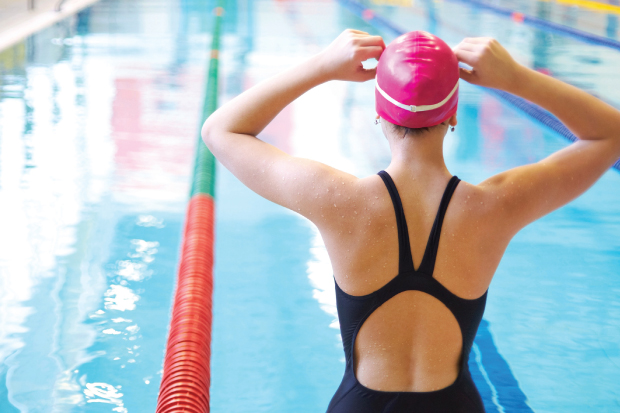Pick Up the Pace!

Winter is a great time to work on your swimming. No, really! You can focus on both your technique and your speed—without being distracted by all of the demands of upcoming races.
Speaking of speed: A lot of people pick one, comfortable speed; they train by swimming laps at that one speed and then race at that same speed, leaving the water feeling as though they could have gone harder. That you need to train faster if you want to race faster—an idea that might sound like a no brainer—is a concept that tends to surprise some of my clients.
Why faster training? Your body adapts to the type of workouts you do, so, if you only ever train at one pace, you will only ever race at one pace. You need to train your body to swim at faster speeds. A great way to do this is by breaking up your workout into smaller chunks and swimming on intervals. This gives you rest, which allows you to swim at a faster pace. Masters swimmers and those who have swum on teams will be familiar with this type of workout, but there are lots of folks out there who don’t have that experience. For those swimmers, interval workouts may be a new concept.
Initial Testing
One of the keys to learning how to swim at a faster pace is to be aware of the time you can hold for 100 yards. Do a test set by using your watch or the clock at the pool to check what time you can maintain for a number of 100-yard aerobic efforts, with 20–30 seconds rest after each. If you are swimming at an aerobic pace, your 100 times should stay fairly consistent over distances of 500–1,500 yards (5-15 repeats).
What Defines Speed in the Water
Your long-term goal is to bring your average 100-yard time down, so what do you do to swim faster? Swimming faster is a product of two things: stroke rate and distance per stroke. Stroke rate is how quickly your arms turn over and distance per stroke is the distance traveled in each stroke, which is a product of your efficiency (how well you hold the water) and your strength. There is a trade-off between stroke rate and distance per stroke; swimming faster requires that you find the optimal combination of increasing your stroke rate (turning your arms over more quickly) and maintaining distance per stroke (having powerful, efficient strokes). In other words, you don’t want your arms to go around fast but slip through the water.
Training with Speed
To help find that optimal combination—one that you can hold for the distance you want to race—and to test your ability to change speeds, swim sets of three descending 100s with 30 seconds rest after each 100 yard effort. “Descending” means “going faster”; another way to think of this is that you will swim at 70 percent effort, then 80 percent, and finally 90 percent. How many of these sets of threes you do will depend on your current fitness level and the distance you are training for.
 Consider these factors during your sets:
Consider these factors during your sets:
- Try different ways to get faster over those 100 yards: faster strokes, more powerful strokes, or a combination of the two.
- Be sure to note your times.
- Count your strokes on the last 25 yards of each 100 to get a sense of your distance per stroke.
By counting your strokes, you can find what means faster for you: taking more strokes or taking fewer but more powerful strokes? Counting will also show how your stroke count changes as you get fatigued. Beware: Faster stroke rate alone seldom equates to faster times!
After doing your set of descending 100s, you should have an idea of what efficient speed feels like and how fast your can go. You can now break your workouts down into multiples of 100 yards (100s, 200s, 400s, etc.), assigning a base time per 100 as a goal. As you progress, you can swim the same sets with less rest in between repeats, still trying to keep that same faster goal time. After a few weeks of training with these intervals, run through your test set again. Your times should be faster while your rest interval remains the same.
Vary your workouts; don’t do the same thing every time you go to the pool. There are lots of great websites and apps that can help you find interesting sets and workouts that will challenge your speed and endurance. Try training faster and just watch yourself race faster next season!






